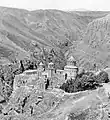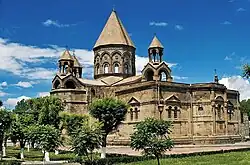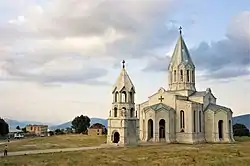  _(39711448964).jpg.webp)    From top to bottom: Saint Stepanos Monastery of Julfa (12th century); Church of the Holy Apostles in Ani (c. 9th century); Aghtamar cathedral (c. 8th century); Etchmiadzin cathedral and its Dome (4th century); Monastery of Geghard (13th century); and Kumayri historic district (19th century) | |
| Years active | c. 3rd millennium BC – present |
|---|---|
Armenian architecture comprises architectural works with an aesthetic or historical connection to the Armenian people. It is difficult to situate this architectural style within precise geographical or chronological limits,[1] but many of its monuments were created in the regions of historical Armenia, the Armenian Highlands.[2] The greatest achievement of Armenian architecture is generally agreed to be its medieval churches and seventh century churches, though there are different opinions precisely in which respects.
Common characteristics of Armenian architecture

Medieval Armenian architecture, and Armenian churches in particular, have several distinctive features, which some believe to be the first national style of a church building.[3]
Common characteristics include:
- Pointed domes, reminiscent of the volcanic cone of Greater Ararat. The conical or semiconical radially segmented dome or cupola is mounted above vaulted ceilings on a cylindrical drum (usually polygonal on the outside, most often octagonal)[4]
- The vertical emphasis of the whole structure, with the height often exceeding the length of a church[4]
- Reinforcement of the verticality with tall, narrow windows[4]
- Stone vaulted ceilings
- Composed almost entirely of stone, usually volcanic tuff or basalt.
- A composite roof composed of finely cut tuff shingles
- Frescoes and carvings, if present, are usually ornate and include swirling intertwining grapevines and foliage.
- Heavy use of tall structural arches, both for supporting the cupola as part of the drum, the vaulted ceiling, and the vertical walls.
- Roofs intersecting to support the dome, both in basilicas and centrally planned churches.
- Sculptural decoration of external walls, including figures.
Classification of Armenian churches
    .jpg.webp)  From top to bottom: Sanahin Monastery; Haghartsin Monastery; Haghpat Monastery; Goshavank; Tatev Monastery; Noravank |

Within the bounds of the aforementioned common characteristics, individual churches display considerable variation which may reflect time, place, and the creativity of its designer. Toros Toramanian distinguished the following classical styles while studying these variations in the early 20th century:[4]
| Style | Armenian nomenclature | Example |
|---|---|---|
| Basilica | Bazilik (Բազիլիկ) | Ererouk |
| Domed basilica | Gmbetakir bazilik (Գմբեթակիր բազիլիկ) | Tekor Basilica |
| Cruciform | Etchmiadznatip (Էջմիածնատիպ; literally "Etchmiadzin-type") | Etchmiadzin Cathedral |
| Vertical-emphasis rectangular | Oughghagitz karankiun (Ուղղագիծ քառանկյուն) | Saint Gayane Church |
| Radial | Sharavighayin (Շառավիղային) | Saint Hripsime |
| Circular | Zvartnotsatip (Զվարթնոցատիպ; literally "Zvartnots-type") | Zvartnots |
Construction

Armenian architecture, as it originates in an earthquake-prone region, tends to be built with this hazard in mind. Armenian buildings tend to be rather low-slung and thick-walled in design. Armenia has abundant resources of stone, and relatively few forests, so stone was nearly always used throughout for large buildings. Small buildings and most residential buildings were normally constructed of lighter materials, and hardly any early examples survive, as at the abandoned medieval capital of Ani.
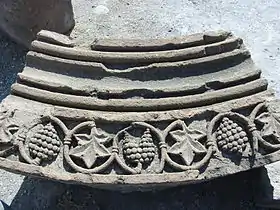
The stone used in buildings is typically quarried all at the same location, in order to give the structure a uniform color. In cases where different color stone are used, they are often intentionally contrasted in a striped or checkerboard pattern.[3] Powder made out of ground stone of the same type was often applied along the joints of the tuff slabs to give buildings a seamless look.[3] Unlike the Romans or Syrians who were building at the same time, Armenians never used wood or brick when building large structures.
Armenian architecture employs a form of concrete[3] to produce sturdy buildings,. It is a mixture of lime mortar, broken tuff, and rocks around which forms a core against which thin slabs of tuff are arranged in brickwork fashion. As the wet mortar mixture dries it forms a strong concrete-like mass sealed together with the tuff around it and, due to tuff's properties, it becomes harder with time. Initially, almost no core was used in the construction of churches, stone blocks were simply sealed together, but as architects saw how those with mortar cores withstood tremors, the size of the core expanded. Frescos of marble or another stone were often affixed to the side of these buildings, usually at a later date.
History of Armenian architecture
The gradual development of Armenian architecture.
Pre-Christian Armenia
During the third millennium B.C, prehistoric Armenian architecture was already distinctive. The most common feature was its groundwork, which incorporated many geometrical shapes, ultimately forming a cell shape. An example of such architecture can be found in Kültəpə, near Nakhchivan. These buildings were approximately 6–7 metres wide and about 5 metres high.[5]
Urban architectural traditions, and other forms of art in the years before Christ continued to develop and later were influenced by Greco-Roman art.[6] Urartian architecture is known for its use of intricately cut rocks, used as foundations for mud brick buildings, usually constructed in a compact manner (such as in Erebuni).

Urartian temples had massive stone walls at lower levels and a relatively small interior space, usually square, and rose high; they were generally placed at the highest point of a site. Higher levels were in mud brick, which has not survived, and it is not fully clear how appeared. The late Temple of Garni of the 1st century AD, in a fully Hellenistic style, is the only pagan monument left in any sort of complete state in Armenia, as many others were destroyed or converted to Christian places of worship under Tiridates III of Armenia.[7] Garni includes local elements of sacred numerology and geometry. The temple has a column to inter column ratio of 1/3 (1 is the primary number of the universe and 3 is the holiest of all numbers as it represents the Greco-Roman triad Jupiter, Juno and Minerva). Aside from being aesthetically beautiful, Garni's design can be seen as being a reaffirmation of the universal laws that governed man's destiny. The angles, number of columns, and dimensions were created with a careful eye; Armenian pagans wanted to appease the gods and protect humanity from their wrath. This sacred geometry is evident in the entire temple. To the people who created it, it was the perfect embodiment of their communion with the universe. Note that although sacred geometry was mostly used in religious buildings, secular buildings adopted some aspects of it.[8]
Pre-Christian and Christian structures
- Stone sculptures of horses and sheep
.jpg.webp)
.jpg.webp)
_01.png.webp) Tombstone in the form of a ram in the Armenian cemetery of Jugha (Julfa)
Tombstone in the form of a ram in the Armenian cemetery of Jugha (Julfa)_02.png.webp) Tombstone in the form of a ram in the Armenian cemetery of Jugha (Julfa)
Tombstone in the form of a ram in the Armenian cemetery of Jugha (Julfa)_03.png.webp) Tombstone in the form of a ram in the Armenian cemetery of Jugha (Julfa)
Tombstone in the form of a ram in the Armenian cemetery of Jugha (Julfa)_04.png.webp) Tombstone in the form of a ram in the Armenian cemetery of Jugha (Julfa)
Tombstone in the form of a ram in the Armenian cemetery of Jugha (Julfa) Stone sheep sculpture in Sardarapat Museum
Stone sheep sculpture in Sardarapat Museum.jpg.webp)

.jpg.webp)




10th century BC – 1st century BC

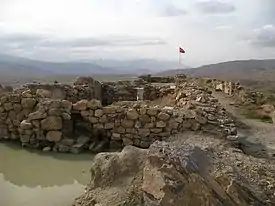
 Musasir, 825 BC
Musasir, 825 BC The Van Citadel, 9th century BC
The Van Citadel, 9th century BC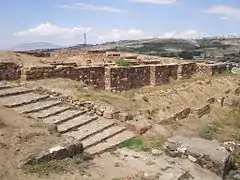 Erebuni Fortress, 782 BC
Erebuni Fortress, 782 BC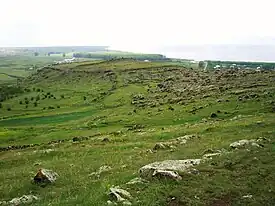 Odzaberd, 735–713 BC
Odzaberd, 735–713 BC Teishebaini, Between 650 and 600 BC
Teishebaini, Between 650 and 600 BC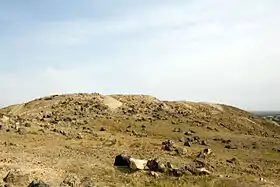 Argishtikhinili, 8th and 6th centuries BC
Argishtikhinili, 8th and 6th centuries BC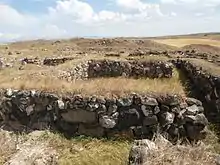

 Artaxata, 176 BC
Artaxata, 176 BC.jpg.webp) Tigranakert of Artsakh, 2nd–1st century BC
Tigranakert of Artsakh, 2nd–1st century BC.JPG.webp) Mount Nemrut, 1st century BC
Mount Nemrut, 1st century BC
Christian Armenia

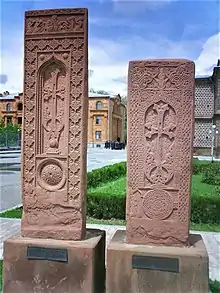
Christianity's institution as Armenia's official religion in 301 allowed new developments in Armenian architecture, which nevertheless preserved older traditions.[6] In fact it would be almost impossible to find any religion that rose completely on its own without borrowing some traditions from the past. Exploring Armenian churches is critical to our understanding of Medieval Armenia. Beyond that, the Armenian churches describe us the general landscape of the Christian East at a time when eyewitness accounts were exceedingly rare. In their messages of authenticity and legitimacy, the churches shaped and preserved public memory, negotiating among diverse linguistic, religious, political, and ethnic groups.[9]
The first Armenian churches were built on the orders of St. Gregory the Illuminator, and were often built on top of pagan temples, and imitated some aspects of Armenian pre-Christian architecture.[8]
Gallery 4th–7th century

 Aghperig Monastery, 300
Aghperig Monastery, 300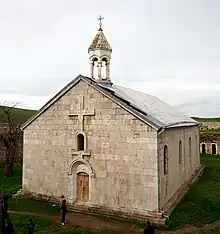

 Saint Hripsime Church (Vermashen), 4th century
Saint Hripsime Church (Vermashen), 4th century
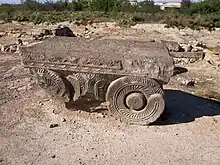
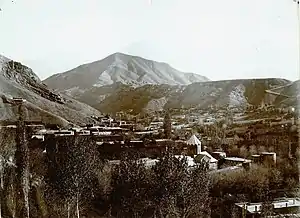
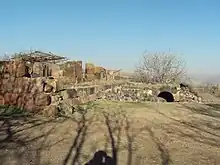






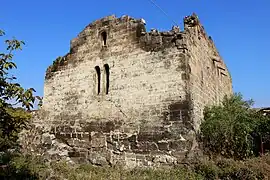


 Tekor Basilica, end of 5th century
Tekor Basilica, end of 5th century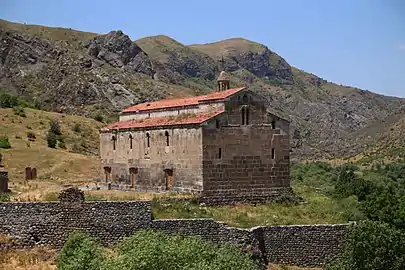
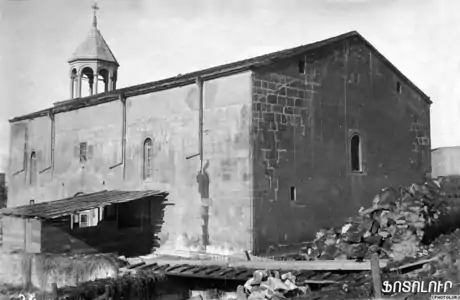
_(6).jpg.webp) Holy Mother church (Kurtan), 5th-6th century
Holy Mother church (Kurtan), 5th-6th century Tormak, 5th-6th century
Tormak, 5th-6th century



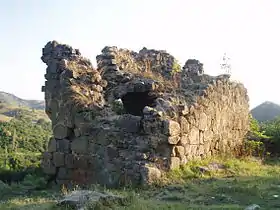
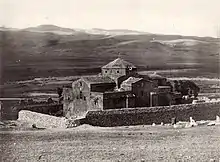 Bagavan church, 613–619
Bagavan church, 613–619.jpg.webp)
 Saint Gayane Church, 630
Saint Gayane Church, 630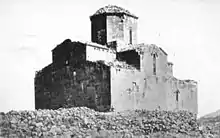 Cathedral of Mren, 631–639
Cathedral of Mren, 631–639 Ruins of Zvartnots Cathedral, 641–652
Ruins of Zvartnots Cathedral, 641–652 Varagavank, 653
Varagavank, 653.JPG.webp) Bana cathedral, 653–658
Bana cathedral, 653–658 Gharghavank, 661–685
Gharghavank, 661–685

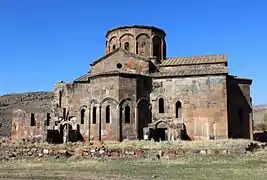
8th–14th century
.jpg.webp)

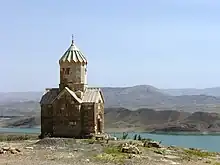


_17-11-2019v1.jpg.webp)
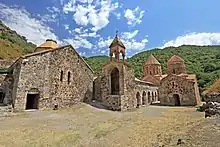
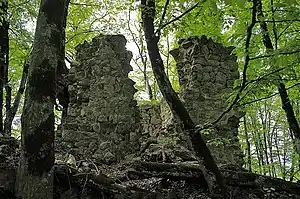
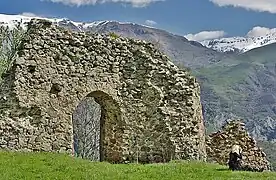
_-_%D5%8D%D5%B8%D6%82%D6%80%D5%A2_%D4%B1%D5%B4%D5%A5%D5%B6%D5%A1%D6%83%D6%80%D5%AF%D5%AB%D5%B9_%D5%A5%D5%AF%D5%A5%D5%B2%D5%A5%D6%81%D5%AB.jpg.webp)

 Tatev Monastery, 895–906
Tatev Monastery, 895–906 Vanevan Monastery, 903
Vanevan Monastery, 903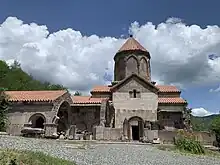 Vahanavank, 911
Vahanavank, 911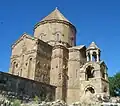
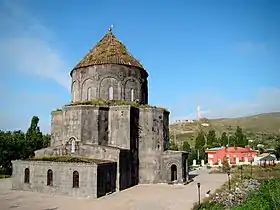 Cathedral of Kars 930–967
Cathedral of Kars 930–967 Gndevank, 931–936
Gndevank, 931–936
 Sanahin Monastery, 957–966
Sanahin Monastery, 957–966 Haghpat Monastery, 976–991
Haghpat Monastery, 976–991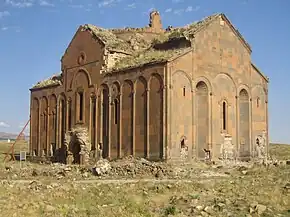 Cathedral of Ani, 989–1001
Cathedral of Ani, 989–1001_02.jpg.webp)

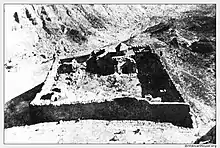

.jpg.webp)
-1.jpg.webp)



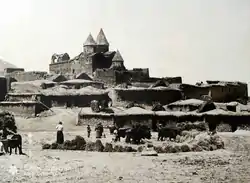

.JPG.webp)

.jpg.webp)
.jpg.webp)
 Vorotnavank, 1000.
Vorotnavank, 1000. King Gagik's church of St Gregory, Ani, 1001–1020
King Gagik's church of St Gregory, Ani, 1001–1020 Vahramashen Church, 1026
Vahramashen Church, 1026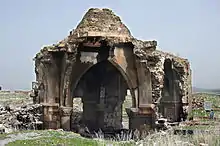
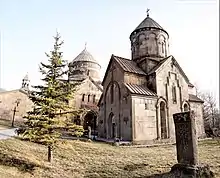 Kecharis Monastery, 1033
Kecharis Monastery, 1033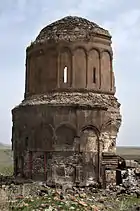
 Bgheno-Noravank, 1062
Bgheno-Noravank, 1062.jpg.webp) Meghri Fortress, 1083
Meghri Fortress, 1083
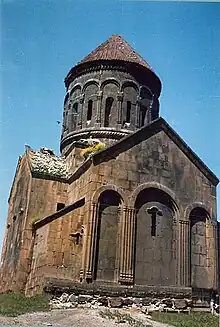


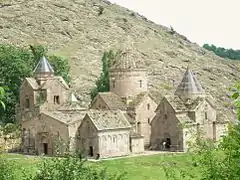 Goshavank, 1191–1196
Goshavank, 1191–1196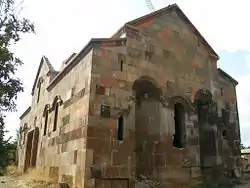


.jpg.webp)
.jpg.webp)
 Castle of Kars, 1153
Castle of Kars, 1153 Kobayr monastery, 1171
Kobayr monastery, 1171 Lori Fortress, 1177
Lori Fortress, 1177 Tejharuyk Monastery, 1196–1199
Tejharuyk Monastery, 1196–1199
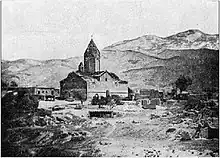

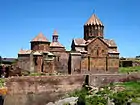 Harichavank Monastery, 1201
Harichavank Monastery, 1201.png.webp) Hogevank Monastery, 1205
Hogevank Monastery, 1205.jpg.webp) Geghard, 1215
Geghard, 1215_Ani_Turkey.jpg.webp)

 Hovhannavank, 1216
Hovhannavank, 1216.JPG.webp) Saghmosavank, 1215–1221
Saghmosavank, 1215–1221 Gtichavank, 1241–1246
Gtichavank, 1241–1246 Matosavank,1247
Matosavank,1247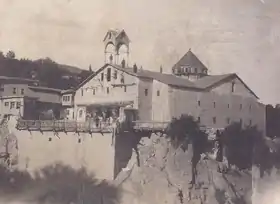 Cathedral of Arapgir, 1249
Cathedral of Arapgir, 1249 Saint George's Church, 1251 or earlier
Saint George's Church, 1251 or earlier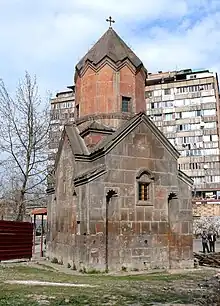
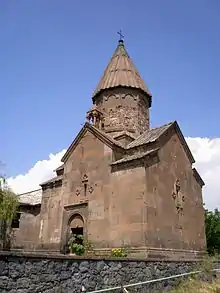


.JPG.webp)
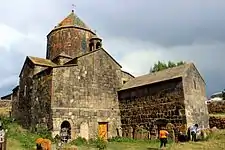
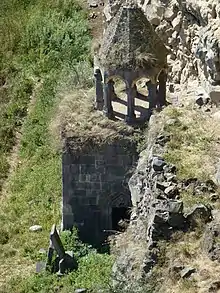




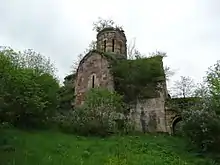

.jpg.webp)

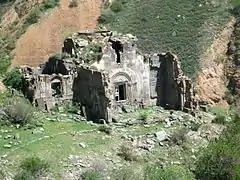






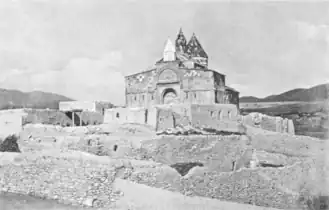




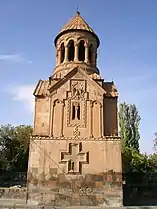
 Lim Island, 1305
Lim Island, 1305 Saint Thaddeus Monastery, 1319–1329
Saint Thaddeus Monastery, 1319–1329 Areni Church, 1321
Areni Church, 1321.jpg.webp) Spitakavor Monastery, 1321–1330
Spitakavor Monastery, 1321–1330 Orbelian's Caravanserai, 1332
Orbelian's Caravanserai, 1332 Noravank, 1339
Noravank, 1339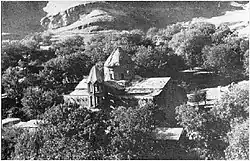
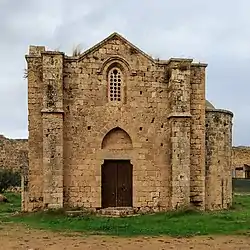 Ganchvor monastery, 1364
Ganchvor monastery, 1364 Armenian Cathedral of Lviv, 1363–1370
Armenian Cathedral of Lviv, 1363–1370

1.jpg.webp)

.JPG.webp)
15th–18th century

 Forty Martyrs Cathedral, 1491
Forty Martyrs Cathedral, 1491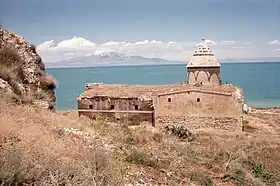


 Norashen Church, 1507
Norashen Church, 1507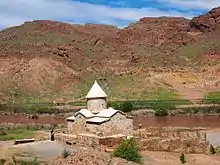 Chapel of Chupan, 1518
Chapel of Chupan, 1518 St. Georg Church, 1611
St. Georg Church, 1611 Bedkhem Church, 1627
Bedkhem Church, 1627
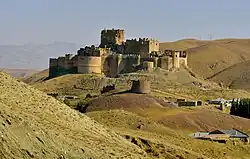 Hoşap Castle, 1649
Hoşap Castle, 1649 Vank Cathedral, 1655–1664
Vank Cathedral, 1655–1664 Khor Virap, 1661
Khor Virap, 1661 Saint Gevork Monastery of Mughni, 1661–1669
Saint Gevork Monastery of Mughni, 1661–1669.jpg.webp)
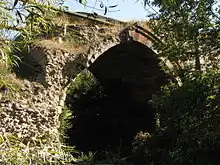 Red Bridge, 1679
Red Bridge, 1679 Gethsemane Chapel, 1690s
Gethsemane Chapel, 1690s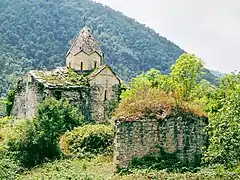
 Surp Astvatsatsin Church, 1338–1693
Surp Astvatsatsin Church, 1338–1693 Shoghakat Church, 1694
Shoghakat Church, 1694.jpg.webp)
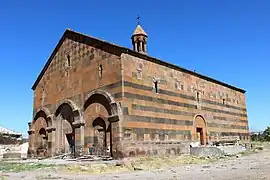

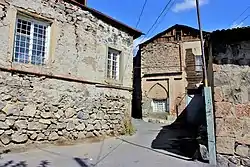
.jpg.webp) Saint Karapet Church, 1705
Saint Karapet Church, 1705.jpg.webp) Surb Nshan Church, 1703–1711
Surb Nshan Church, 1703–1711
.jpg.webp) St. Mary's Church, 1718
St. Mary's Church, 1718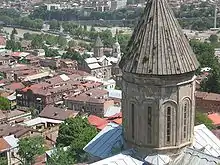
 Jigrashen Avetyats Church, 1624 or 1729
Jigrashen Avetyats Church, 1624 or 1729
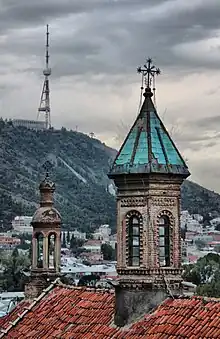 Church of Saint George, 1753
Church of Saint George, 1753.png.webp) Church of the Red Gospel, 1775
Church of the Red Gospel, 1775.jpg.webp) Saint Catherine's Armenian Church, 1771–1776
Saint Catherine's Armenian Church, 1771–1776 Holy Resurrection Church, 1781
Holy Resurrection Church, 1781.jpg.webp)
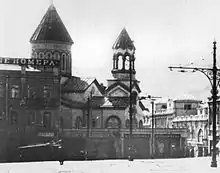 Kamoyants Saint Gevork Church, 1727 or 1788
Kamoyants Saint Gevork Church, 1727 or 1788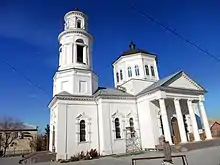 Church of the Ascension, 1790
Church of the Ascension, 1790 Holy Cross Church, 1786–1792
Holy Cross Church, 1786–1792.jpg.webp) Church of St. Gevorg (Sighnaghi), 1793
Church of St. Gevorg (Sighnaghi), 1793 St. George's Church, 1795
St. George's Church, 1795.jpg.webp)


.JPG.webp) Surp Gevork Church, Noragavit, 18th century
Surp Gevork Church, Noragavit, 18th century.jpg.webp)
19th–20th century


 Nor Ejmiatsin Church, 1806–1809
Nor Ejmiatsin Church, 1806–1809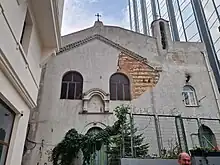
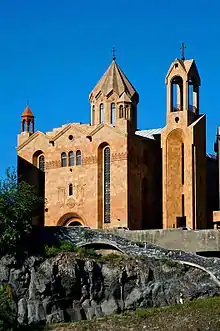 Saint Sarkis Cathedral, 1842
Saint Sarkis Cathedral, 1842
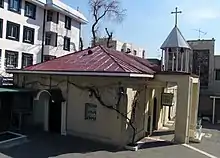

 Armenian Church, Baku, 1863–1869
Armenian Church, Baku, 1863–1869 Lower Bethlehemi Church, 1868–1870
Lower Bethlehemi Church, 1868–1870.jpg.webp)
 Church of the Holy All-Savior, 1860–1871
Church of the Holy All-Savior, 1860–1871 Holy Saviour's Church, 1858–1872
Holy Saviour's Church, 1858–1872.jpg.webp) Gevorgian Seminary, 1874
Gevorgian Seminary, 1874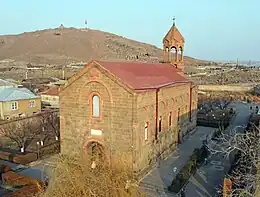 Saint Mesrop Mashtots Church, 443–1879
Saint Mesrop Mashtots Church, 443–1879.jpg.webp) St. Karapet's Church, 1881
St. Karapet's Church, 1881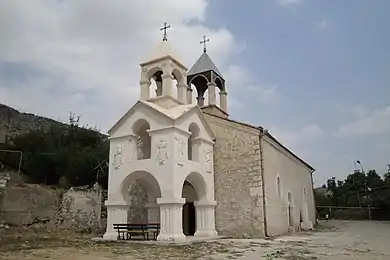
.jpg.webp) Cathedral of the Holy Mother of God, 1873–1884
Cathedral of the Holy Mother of God, 1873–1884 Church of St. George of Samatya, 1866–1887
Church of St. George of Samatya, 1866–1887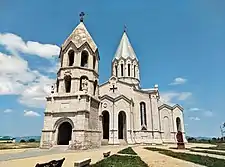 Ghazanchetsots Cathedral, 1868–1887
Ghazanchetsots Cathedral, 1868–1887

.jpg.webp)
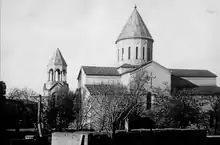

.jpg.webp) St. Astvatsatsin Church, 1902–1905
St. Astvatsatsin Church, 1902–1905

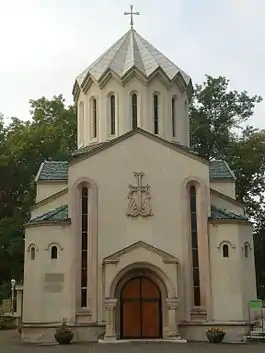 Church of Surp Hakob, 1967–1969
Church of Surp Hakob, 1967–1969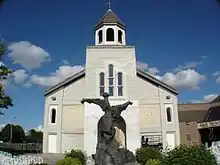
 St. Sarkis Church, 1998
St. Sarkis Church, 1998
Khachkar
 Khachkars in Talin Cathedral, 9th century
Khachkars in Talin Cathedral, 9th century Mughni Church, 986Khachkar
Mughni Church, 986Khachkar Goris, 991
Goris, 991 Vagharshapat, 996
Vagharshapat, 996.jpg.webp) Haghpat Monastery, 1023
Haghpat Monastery, 1023 1056
1056_(6).jpg.webp) Khachkar of Queen Sophie, 1081
Khachkar of Queen Sophie, 1081
 Vagarshapat, 1148
Vagarshapat, 1148 Sanahin, 1184
Sanahin, 1184 Aprank, 1194
Aprank, 1194

.jpg.webp)

 1210
1210 Haghpat Monastery 1211
Haghpat Monastery 1211 1211
1211 Geghard Monastery, 1213
Geghard Monastery, 1213.jpg.webp) Sanahin, 1215
Sanahin, 1215 Haghpat Monastery, 1220
Haghpat Monastery, 1220 Vagharshapat, 1233
Vagharshapat, 1233 1251
1251 Sanahin, 1262
Sanahin, 1262 Geghard Monastery, 1263
Geghard Monastery, 1263 1271
1271 1271
1271 Haghpat Monastery, 1273
Haghpat Monastery, 1273 Etchmiadzin Cathedral, 1279
Etchmiadzin Cathedral, 1279 Geghard Monastery, 1283
Geghard Monastery, 1283 Dadivank, 1283
Dadivank, 1283 1285
1285 Goshavank Khachkar, carved in 1291 by the artist Poghos
Goshavank Khachkar, carved in 1291 by the artist Poghos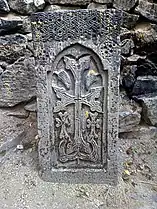 1298
1298


 Armenian-inscribed double khachkars of the Memorial Bell-Tower of the Dadivank Monastery
Armenian-inscribed double khachkars of the Memorial Bell-Tower of the Dadivank Monastery A 15th century khachkar at the Armenian Cathedral of Saint James, Jerusalem
A 15th century khachkar at the Armenian Cathedral of Saint James, Jerusalem
Periods in Armenian architecture
Classical and Medieval Armenian architecture is divided into four separate periods.[3]
The formative period
The first Armenian churches were built between the 4th and 7th century, beginning when Armenia converted to Christianity, and ending with the Arab invasion of Armenia. The early churches were mostly simple basilicas, but some with side apses. By the 5th century the typical cupola cone in the center had become widely used. By the 7th century, centrally-planned churches had been built and a more complicated niched buttress and radiating Hrip'simé style had formed. By the time of the Arab invasion, most of what we now know as classical Armenian architecture had formed.[10]
Bagratid revival


From the 9th to 11th century, Armenian architecture underwent a revival under the patronage of the Bagratid dynasty with a great deal of building done in the area of Lake Van, this included both traditional styles and new innovations. Ornately carved Armenian khachkars were developed during this time.[7] Many new cities and churches were built during this time, including a new capital at Lake Van and a new Cathedral on Akdamar Island to match. The Cathedral of Ani was also completed during this dynasty. It was during this time that the first major monasteries, such as Haghpat and Haritchavank were built. This period was ended by the Seljuk invasion.
Monasteries flourish
From the 12th to 14th century under the Zakarid dynasty saw an explosion in the number of monasteries built, including Saghmosavank Monastery, the Akhtala monastery, Kaymaklı Monastery, Kecharis Monastery and Makaravank Monastery. Monasteries were institutes of learning, and much of medieval Armenian literature was written in this time period. The invasion of Timurlane and the destruction of Cilician Armenia ended architectural progression from another 250 .
Seventeenth century
The last great period in classic Armenian construction was under the Iranian Safavid Shahs, under which a number of new churches were built, usually at existing holy sites such as Etchmiadzin as well as in diaspora communities like New Julfa.[3]
Nineteenth century
Armenian architecture experienced a huge stage of development during the 19th century, when the Russians entered Eastern Armenia. A number of architectural masterpieces were built in the Kumayri historic district of Alexandropol and Yerevan, as well in Kars, which is now a part of the Republic of Turkey.
The Armenian buildings of that time were mainly made of black tuff, therefore those buildings were mainly of black color.
Gallery of Armenian architecture of the 19th century – 20th century
Modern times
One of the most prolific architects of Armenian architectural monuments in the 20th century was Baghdasar Arzoumanian. Based in Yerevan, Armenia, he was the author of a great number of civil and church buildings along with other designs. The legendary architects of the 20th century were Alexander Tamanyan, Rafael Israyelyan, G. Kochar, E. Tigranyan, S. Safaryan, etc. Today the masters of Armenian architecture are S.Gurzadyan, S. Kalashyan, L. Khristaforyan, R. Asratyan etc.
Devastation of Armenian architecture

As a result of Anti-Armenianism, relics of Armenia's past such as churches, cemeteries and khachkars in neighboring countries have been subject to devastation. In certain cases such as in Turkey or Azerbaijan, this had been as a result of national campaigns to eradicate traces of the Armenian people to thwart any potential claims by the Armenian state.
The largest collection in the world was formerly to be found at the ruins of Old Jugha in Nakhichevan (today's Azerbaijan). Reports (see RFE/RL) and photographs from observers in Iranian territory emerged at the end of 2005 showing Azeri soldiers making deliberate attempts to destroy the gravestones. More recent photographs have revealed that the entire graveyard has been obliterated and a military training ground has been constructed on the site.[11]
Armenian architecture in the diaspora
The tumultuous past of Armenia over the last millennium has resulted in the formation of an extensive Armenian Diaspora in various corners of the globe. Armenian communities seeking to keep the traditions of their homeland, influenced the architectural vernacular of Armenian Quarters in cities such as Zamość and Lviv. This influence is most evident in the sacred architecture of churches built by the Armenian community, where designs based on historic landmarks such as the cathedrals of Ani, Zvartnots and Etchmiadzin have been used as inspirational templates to construct these structures in their new surroundings. This tradition still continues into the present day as Armenian immigration has shifted away from the traditional areas of outmigration in Europe and the Middle East into the Americas and Australia.
Khachkars have also become additional signifiers of Armenian identity and have been erected in recent year in cities such as Wrocław, Kraków, Elbląg in Poland, Novi Sad in Serbia, Beirut in Lebanon as well as in Dearborn, Michigan.
.jpg.webp)
 Church of the Nativity, 325–565.
Church of the Nativity, 325–565.
20th century secular buildings in Armenia
- 20th century
 National Assembly (1918).
National Assembly (1918). Yerevan State University in 1968, (1919).
Yerevan State University in 1968, (1919). Yerevan State Medical University in 1960s, (1920).
Yerevan State Medical University in 1960s, (1920). Yerevan opera house by A. Tamanyan in 1951, (1926–1939).
Yerevan opera house by A. Tamanyan in 1951, (1926–1939). Unevermag of Yerevan (1935).
Unevermag of Yerevan (1935). Moscow Cinema (1936).
Moscow Cinema (1936)..jpg.webp)
 The Victory Bridge, Yerevan on Hrazdan River (1945).
The Victory Bridge, Yerevan on Hrazdan River (1945). Pak Suka in 1968, (1952).
Pak Suka in 1968, (1952). Matenadaran (1920–1959).
Matenadaran (1920–1959).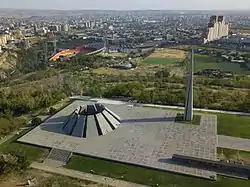 Tsitsernakaberd (1967).
Tsitsernakaberd (1967)..jpg.webp) Erebuni Museum (1968).
Erebuni Museum (1968).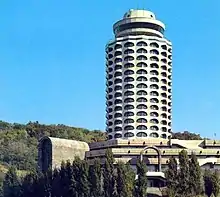 Yerevan Youth Palace (1970).
Yerevan Youth Palace (1970). Republic Square, Yerevan by A.Tamanyan in 1953, (1926–1977).
Republic Square, Yerevan by A.Tamanyan in 1953, (1926–1977). Komitas Chamber Music House (1977).
Komitas Chamber Music House (1977)..jpg.webp) Yerevan Cascade (1971–1980).
Yerevan Cascade (1971–1980). Karen Demirchyan Complex (1983).
Karen Demirchyan Complex (1983).
- Buildings
 Residential building with Armenian decoration in Yerevan
Residential building with Armenian decoration in Yerevan







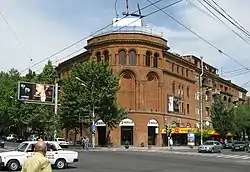

.jpg.webp)

.jpg.webp)
.jpg.webp)



21st century buildings in Armenia
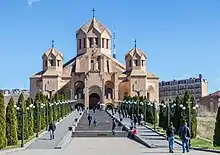 Saint Gregory the Illuminator Cathedral, 1997–2001
Saint Gregory the Illuminator Cathedral, 1997–2001 Holy Trinity Church, 2001–2003
Holy Trinity Church, 2001–2003 Church of St. Nerses the Great, 2004 .
Church of St. Nerses the Great, 2004 . Saint Anna Church, 2011–2014
Saint Anna Church, 2011–2014 COAF SMART center in the village of Debet, Lori province.
COAF SMART center in the village of Debet, Lori province. Holy Mother of God Cathedral, 2006–2019
Holy Mother of God Cathedral, 2006–2019
UNESCO designated World Heritage Sites
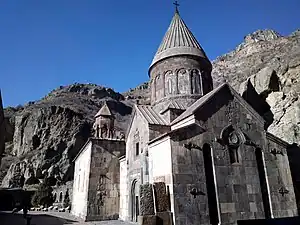
Armenian cross-stones art and Symbolism and craftsmanship of Khachkars, listed to UNESCO intangible world heritage site. The following is a list of World Heritage Sites designed or constructed by Iranians, or designed and constructed in the style of Armenian architecture:
- Incide Armenia
- Outside Armenia
- Church of the Holy All-Savior of Derbent in Russia
- Ani in Turkey
- Ani Cathedral in Turkey
- The church of the Holy Redeemer in Turkey
- The church of St Gregory of the Abughamrents in Turkey
- The church of St Gregory of Tigran Honents in Turkey
- Monastery of the Hripsimian Virgins in Turkey
- King Gagik's church of St Gregory in Turkey
- St. Thaddeus Monastery in Iran
- Saint Stepanos Monastery in Iran
- Chapel of Dzordzor in Iran
- Chapel of Chupan in Iran
- Church of the Holy Mother of God, Darashamb in Iran
Gallery
Examples of Armenian religious architecture
Armenia
 The Holy Trinity Church (2003) modeled after Zvartnots Cathedral, in the Malatia-Sebastia district of Yerevan
The Holy Trinity Church (2003) modeled after Zvartnots Cathedral, in the Malatia-Sebastia district of Yerevan The Saint Gregory of Narek Cathedral (2005) in Vanadzor, Armenia
The Saint Gregory of Narek Cathedral (2005) in Vanadzor, Armenia
Azerbaijan and Artsakh
_Church.JPG.webp) 13th century Gandzasar monastery, near Vank village
13th century Gandzasar monastery, near Vank village
 4th century Amaras Monastery near Sos village
4th century Amaras Monastery near Sos village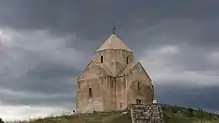 7th century Vankasar Church near Tigranakert
7th century Vankasar Church near Tigranakert 4th century Katarovank close to Hin Tagher village
4th century Katarovank close to Hin Tagher village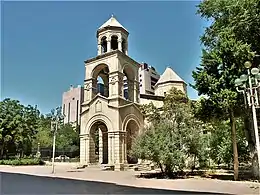
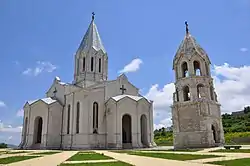

 Tsitsernavank, near Tsitsernavank village
Tsitsernavank, near Tsitsernavank village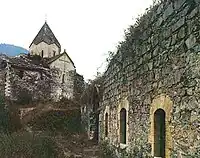
 12th-century Holy Mother of God Church, Hunarli, Azerbaijan
12th-century Holy Mother of God Church, Hunarli, Azerbaijan
Iran
Turkey
Elsewhere in Western Asia
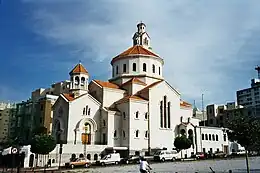
 The Holy Mother of God Cathedral (1940) at the Catholicossate of the Great House of Cilicia in Antelias, Lebanon
The Holy Mother of God Cathedral (1940) at the Catholicossate of the Great House of Cilicia in Antelias, Lebanon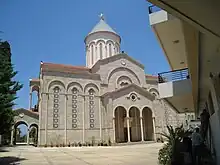 Holy Cross Church (Sourp Nshan) in downtown Beirut, Lebanon, adjacent to the Grand Serail
Holy Cross Church (Sourp Nshan) in downtown Beirut, Lebanon, adjacent to the Grand Serail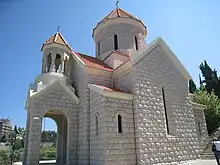 Holy Mother of God Church (Sourp Asdvadzadzin) at the Armenian Seminary in Bikfaya, Lebanon
Holy Mother of God Church (Sourp Asdvadzadzin) at the Armenian Seminary in Bikfaya, Lebanon.jpg.webp)
 The belfry of the Forty Martyrs Armenian Cathedral of Aleppo erected in 1912
The belfry of the Forty Martyrs Armenian Cathedral of Aleppo erected in 1912

 Interior of St. Gregory The Illuminator Church of Cairo
Interior of St. Gregory The Illuminator Church of Cairo
North America
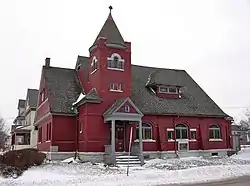 St. Paul's Armenian Apostolic Church, (1908).
St. Paul's Armenian Apostolic Church, (1908).
 Saint Paul Armenian Church (1979) in Fresno, California
Saint Paul Armenian Church (1979) in Fresno, California_crop.JPG.webp) The Saint Gregory the Illuminator Armenian Catholic Church (2001) in Glendale, California
The Saint Gregory the Illuminator Armenian Catholic Church (2001) in Glendale, California
 St Gregory Armenian Church in Springfield, Massachusetts,USA
St Gregory Armenian Church in Springfield, Massachusetts,USA
Russia
 Holy Transfiguration Cathedral, Moscow
Holy Transfiguration Cathedral, Moscow
Singapore
_01.jpg.webp) Armenian Church, Singapore, (1836).
Armenian Church, Singapore, (1836).
See also
References
- ↑ Patrick Donabédian, Jean-Michel Thierry, "Armenian Art", New York, 1989, pp. 29–30
- ↑ Vazken Lawrence Parsegian, 1996
- 1 2 3 4 5 6 Architecture, Arts of Armenia (c) Dr. Dickran Kouymjian , Armenian Studies Program, California State University, Fresno Archived December 31, 2008, at the Wayback Machine
- 1 2 3 4 5 Armen, Garbis (1992), An Architecture of Survival, p. 71, ISBN 0-9695988-0-7
- ↑ History of Armenian Architecture: Volume 1
- 1 2 "Architecture of Armenia – Tourist Guide: Tourism Armenia". Archived from the original on 2018-09-26. Retrieved 2007-06-18.
- 1 2 Armenia, Past and Present; Elisabeth Bauer, Jacob Schmidheiny, Frederick Leist , 1981
- 1 2 Sacred Geometry and Armenian Architecture | Armenia Travel, History, Archeology & Ecology | TourArmenia | Travel Guide to Armenia
- ↑ "Building churches in Armenia: art at the borders of empire and the edge of the canon | Art Bulletin, The | Find Articles at BNET.com". Archived from the original on 2008-01-27. Retrieved 2007-06-18.
- ↑ Edwards, Robert W., "Armenia" (2016). The Eerdmans Encyclopedia of Early Christian Art and Archaeology, ed., Paul Corby Finney. Grand Rapids, Michigan: William B. Eerdmans Publishing. pp. 119–122. ISBN 978-0-8028-9016-0.
{{cite book}}: CS1 maint: multiple names: authors list (link) - ↑ "Azerbaijan famous medieval cemetery vanishes". Archived from the original on 2014-02-17. Retrieved 2012-12-30.
Bibliography
- Armen, Garbis (1992), An Architecture of Survival, ISBN 0-9695988-0-7
External links
- Armenian Historical Monuments Archived 2015-09-23 at the Wayback Machine presented by the Research on Armenian Architecture organization
- Arts of Armenia:Architecture, a chapter in a book by Dickran Kouymjian of Cal State University, Fresno
- Index of Armenian Art: Armenian Architecture, a listing and details of Armenian architecture grouped by classification
- Pictorial Gallery of Armenian Architecture
- Armenian Architecture Collection of the Rensselaer Digital Collections, part of Rensselaer Polytechnic Institute (includes monasteries in Western Armenia)
- Armenian Architecture in Turkey and the City of Ani
- Armenian Architectures and Its Protection in Turkey
- Cilician Armenian Architecture
.jpg.webp)

.jpg.webp)

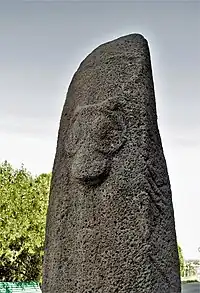

.jpg.webp)




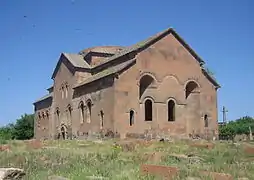

























.jpg.webp)





.jpg.webp)
_19.jpg.webp)





















.JPG.webp)
.JPG.webp)





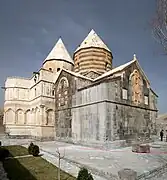
.jpg.webp)
